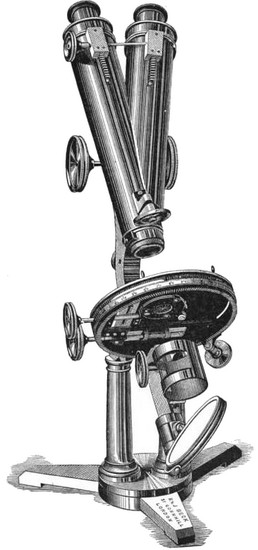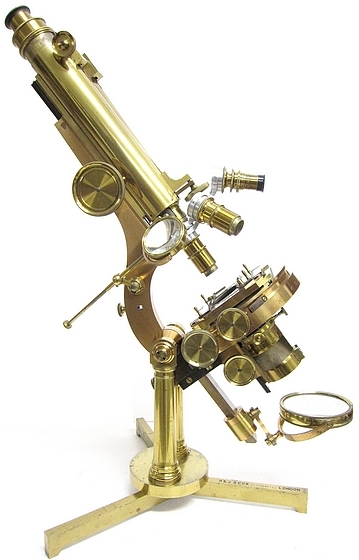
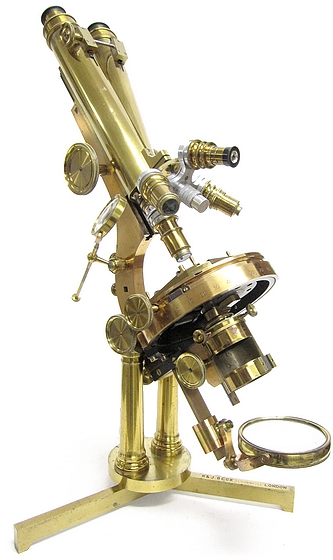
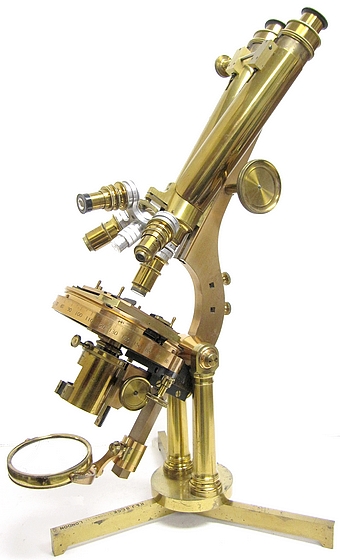
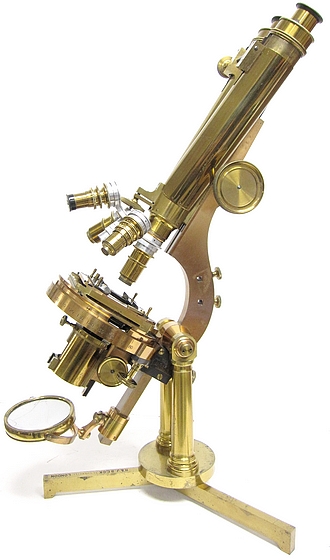
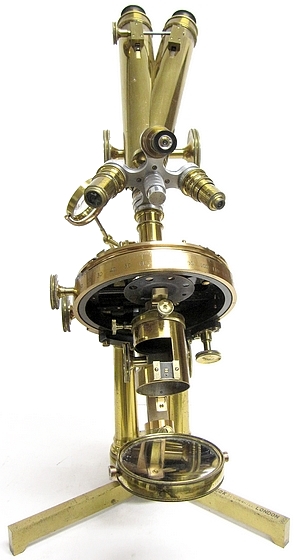
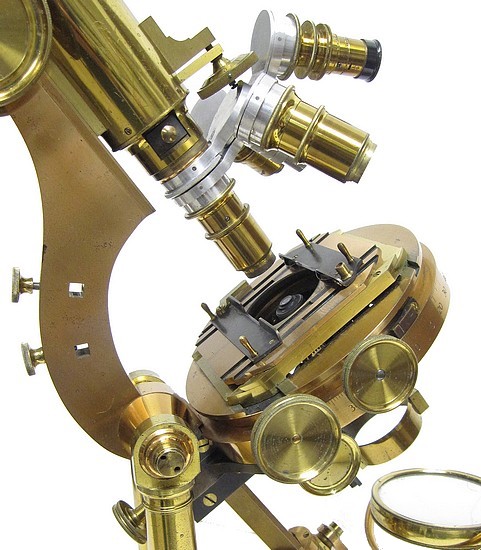
This instrument is supplied with an unusually large group of accessories. The set consists of four mahogany cases. The main brass-bound case contains the microscope and two layers of accessories. The bottom layer is accessed by removing the microscope and the upper trays of accessories. There are three other cases containing additional accessories. Among the accessories are thirteen Beck objectives with brass canisters (with focal lengths 4, 3, 2, 1-1/2, 1/4, two different 4/10 (55° and 90°), 2/3, two different 1/5, 1/8, 1/10, 1/20-inches), three matched pairs of eyepieces, and four single eyepieces of various powers (two are not visible in the photo since they are stored under the large goniometer).
The other accessories supplied with this microscope are listed below. The numbers given in the list correspond to the numbers indicated in the accessory section of the R. & J. Beck 1882 catalog (view the illustrations in the catalog to see what the accessories are like):
66.
Sorby's
spectroscope eye-piece in a mahogany case
(microspectroscope)
67*.
Sorby's
standard spectrum scale
67.
Sorby's
dichroiscope
87-92. Three different
Lieberkuhn reflectors with protective caps
99.
Erecting
glass
100.
Draw-tube
for use of the microscope as a monocular
101.
Achromatic
condenser with revolving diaphram and centering
adjustments
104.
Right-angle
prism for reflecting light instead of the flat
mirror
105.
Amici's
prism for oblique light
107.
Nachet's
substage prism for oblique light
108.
Wenham's
parabolic substage illuminator for dark field
use
110.
Substage
spot lens mounted in a brass fitting
111.
Equilateral
prism on stand for oblique illumination
112.
Adapter
on a stand for object glass as a condenser
113.
Brown's
iris diaphragm
115.
Polarizing
apparatus (includes rotatable mountings for the
analyzing prism either above the eyepiece or above
the objective)
116.
Polarizing
apparatus with extra large prism (substage)
117.
Darker's
series of substage selenites
123*.
Single
double-image prism in fitting
123.
Two
double-image prisms and selenite film with fitting to
eyepieces and a brass plate with holes
124.
Crystals
to show rings around the optical axis
125.
Tourmalines
in a brass mounting
127.
White-cloud
illumintor that fits over the mirror
126.
Beck's
patent illuminator (vertical illuminator) in a brass
box for viewing opaque objects under high
powers
129.
Parabolic
illuminator with addition of Sorby's reflector in
a brass case
130.
Large
bulls-eye condensering lens on stand
131.
Smaller
condensing lens with fitting to the limb
133.
Silvered
side reflector with fitting to the limb
135.
Rainey's
light moderator on stand
136.
Three
dark wells and holder
138.
Opaque-disk
revolver, forceps, and three trays of 24 disk in a mahogany case
142.
Three-prong
forceps
144.
Stage
forceps
145.
Stage
mineral-holder
145*.
Brass
hand forceps
146.
Eyepiece
micrometer with Jackson's adjusting screw
149.
A
brass mounted stage micrometer
150.
Maltwood's
finder in a leather case
152.
Indicators
for some eyepieces
154.
Leeson's
goniometer for measuring crystal angles
155.
Wollaston's
camera lucida
161.
Quadruple
Nose-piece, curved, in aluminum
162.
Lever
compressorium
163.
Parallel
compressor
164.
Reversible
compressor
165.
Wenham's
compressorium for use with Wenham's parabola
166.
Screw
live-box
167.
Large
live-box
168.
Small
live-box
169.
Large
glass trough with wedge
171.
Two
glass slips with ledge
172.
Growing-cell
for persevering objects alive in water for many
days
173-174. Beck's
live trap and trough complete in a mahogany
case
175.
Frog-plate
181.
Key
for tightening joint of first class
microscopes
There are a few other accessories present that are
not disclosed in the 1882 catalog. In addition, the
main case came with a
protective outer leather covering for traveling;
it has dried out and deteriorated somewhat over the
years.
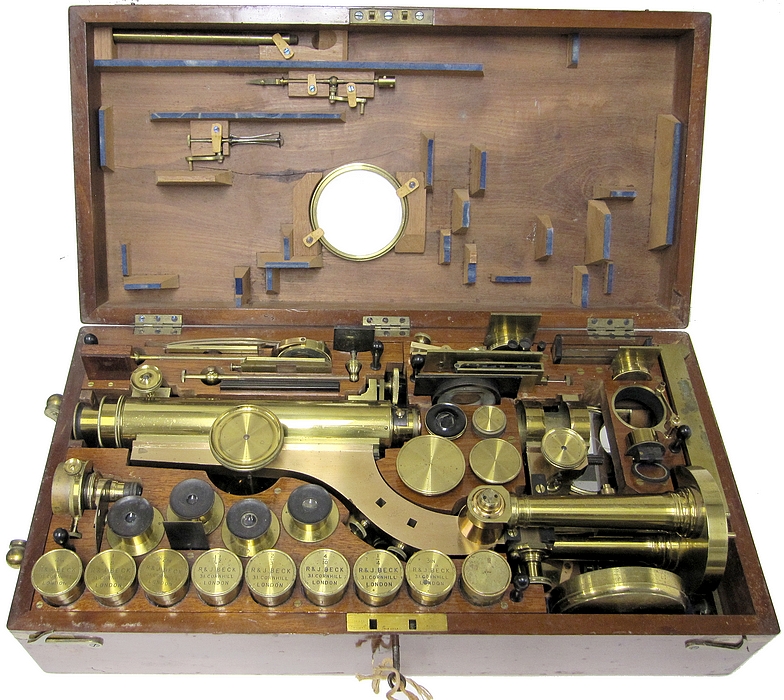
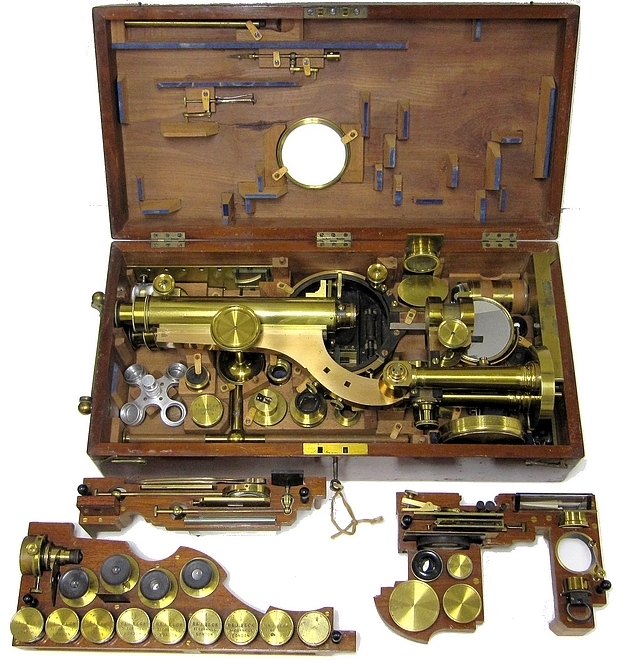
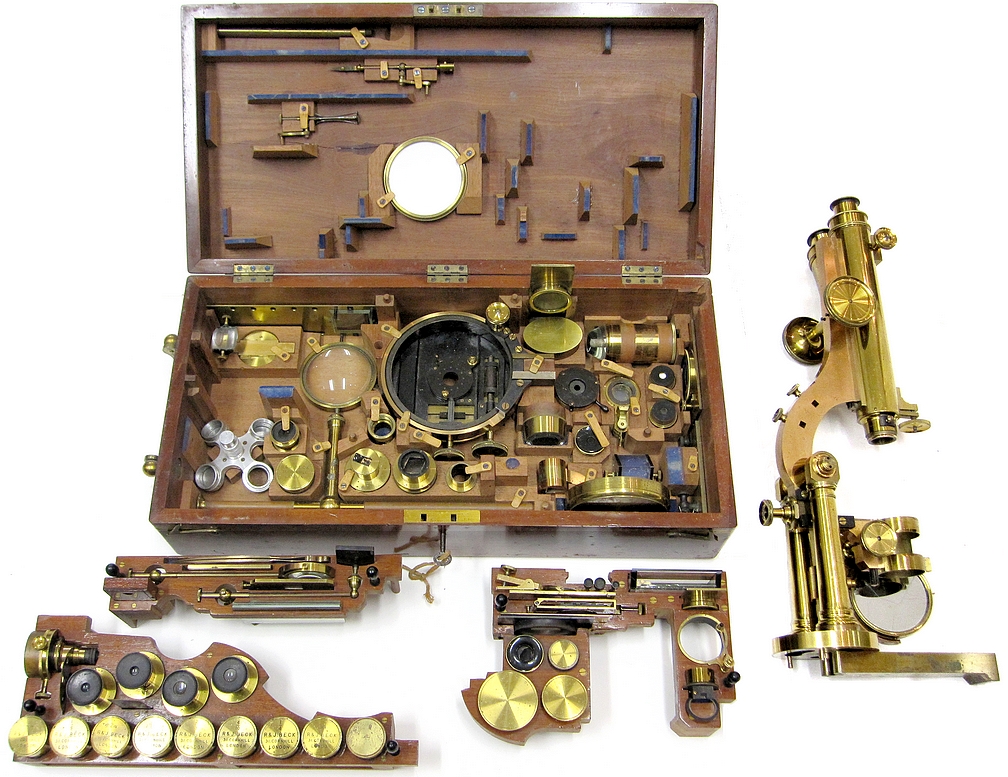
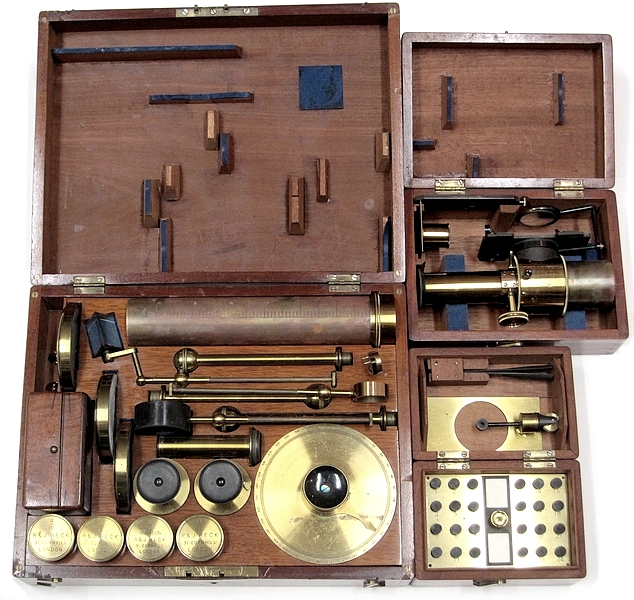
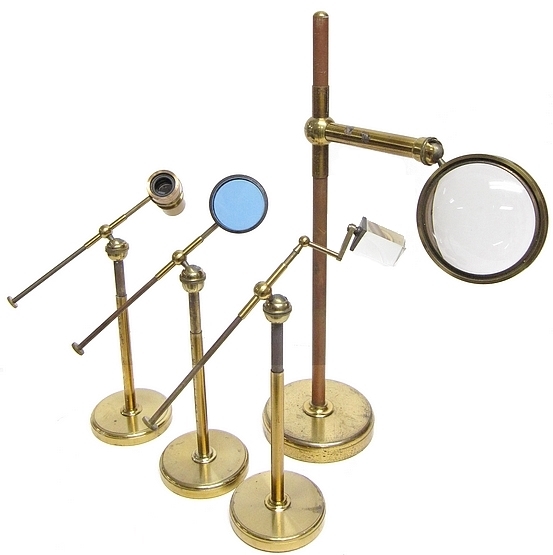
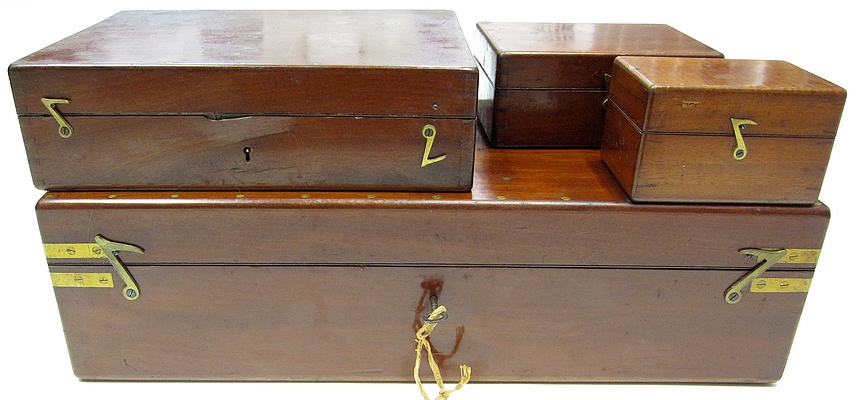
The R. & J. Beck production and delivery books list this microscope as the Large Best Portable model (although it is hardly "portable" in the normal sense of the word). The workman who produced the instrument was G. Gowland. It was completed in July 1872 and shipped to the Beck outlet in September of that year. Unfortunately, the actual purchaser of the microscope was not indicated. However, there is a hint that the purchaser may have been an American or an American institution. The instrument was found for this collection in the USA (it can be traced back to the west coast at least to 1970). Although only hearsay, the person who obtained this microscope in 1970 was told that this microscope was one of two microscopes that "sailed around the Cape". In addition, accompanying the instrument was a cabinet of prepared microscope slides that are contemporary with the microscope. The cabinet is designed to hold 300 slides and is about 2/3 full. The slides include those prepared by American (most with west coast addresses) as well as those by European makers. Significantly, a major proportion of the European slides have stickers that indicate they were retailed by an American supplier (mainly James W. Queen of Philadelphia).
It is perhaps no more than conjecture, but the following is worth noting. In early 1871, Joseph Beck, the notable London optician, visited the San Francisco Microscopical Society where he exhibited a binocular microscope to the members. In the following year, the same year that the microscope shown here was produced, a "large microscope and accessories were purchased at a cost of $1500.00" by the Society (see: a Brief History of the San Francisco Microscopical Society in the American Monthly Microscopical Journal, 1890). Could the microscope purchased by the Society be the one shown on this page? A typical large microscope of the period would not have sold for such a high price in 1872 unless it was one that was sold along with a very large number of accessories. The microscope shown here is one such instrument. Also, a significant number of the slides found with the microscope have labels indicating that the preparers were from San Francisco. Among these men are Wm. Ashburner, Chas. H. Denison, and S. M. Mouser M.D. Each of these gentlemen were early members of the S.F.M.S. Of equal significance with respect to this conjecture is the fact that there are quite a few slides bearing a printed label having a monogram surrounded by the words "Prepared by... S.F.M.S." (the monogram of William Norris, a member of the Society since 1874). Finally, below is an early photo of the rooms of the San Francisco Microscopical Society. At the far end table stands a large binocular microscope on a double pillar. While the details in the photo are not perfectly clear, what can be seen is consistent with the microscope being a Beck Large Best model (image from the Transactions of the S.F.M.S., 1893). In addition, the bullseye condenser shown in the photo next to the microscope appears identical to those supplied with the Beck Large Best. The acquisition of the microscope by the S.F.M.S. in 1872 was a notable event as described in the following quote from The aforementioned Transactions:
"Probably every one who ever placed an order for a new microscope can recall the sensations during the weeks or months which intervened between order and delivery. Evidently all the fond imaginings and wrapt anticipations which the initiated reader can remember must be multiplied by fifteen to express the state of mind of this young society during its first summer. Regular meetings were held, at which the small charms of borrowed stands but suggested contrasts by which to measure coming splendor. All the kingdoms of nature were ransacked for material fit to meet the gleam of this royal binocular. Nine months from the organization the microscope arrived, and its installation was impressive, for the record shows that it was conspicuously placed upon the table by the president, and it was discoursed upon in every line and lineament to the perfect satisfaction of the members, who were now aware that the society existed not only in name but in reality. The coming of this microscope to San Francisco seems to have been, in a certain way, a municipal event, and to have exerted a deep influence upon the community; for the custom-house drayman and the custom-house broker both declined to receive fees upon it. Such officials do not relax fees upon slight occasion. The auspicious arrival of this first microscope of the society foreshadowed its career".
The S.F.M.S. was disbanded in 1906, prior to the infamous earthquake that occurred in April of that year. The fate of the Society's microscopes at that time is unknown. In 1946, the Society was reestablished and is still in existence. The early records of the Society still exist; consultation of these records might provide more detailed information about the Society's large microscope purchased in 1872 (the 1893 Transactions state that by 1874 the Society had two first class microscopes).
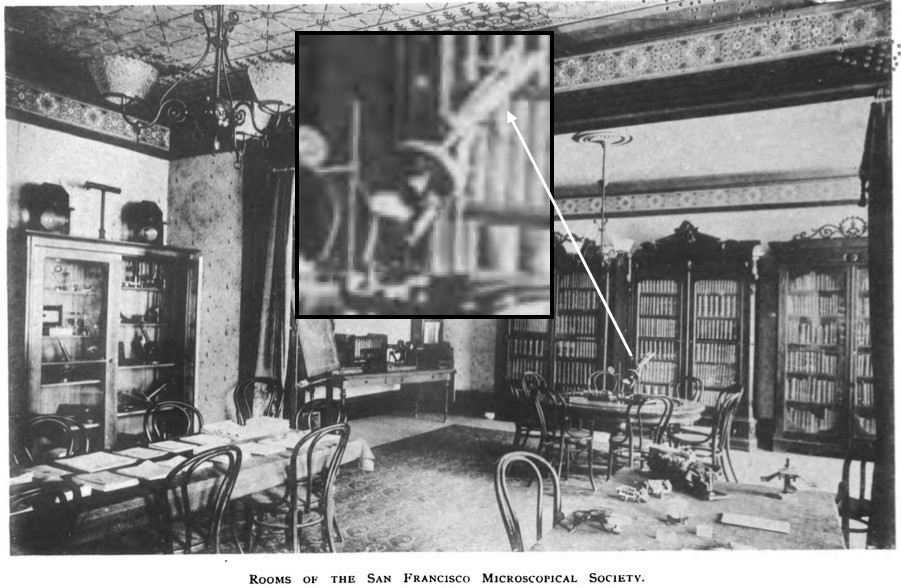
The Large Best Portable model differs from the standard (upright) Large Best in a number of ways. The tripod base of the instrument folds so that it can be stored in a flat case along with the accessories. The large stage is detachable; again, to allow the instrument to be placed flat within the case. On the basis of the entries listed in the R. & J. Beck production books for the years 1867-1898, the portable version of this top of the line model is far less common than the standard version. For example, according to the production books, in 1872, the year when this microscope was produced, only three portable Large Best microscopes were made compared to 49 standard versions of this model. In the 1882 catalog, this portable model was no longer listed as an option while the standard Large Best was still offered for sale. With the exception of the differences noted above, the function and use of the two versions are basically identical. The description of the standard model given below, which is also applicable to the portable model, was extracted from the 5th edition of Carpenter's The Microscope, 1875.
Extracted from the 5th edition of Carpenter's The Microscope, 1875:
Messrs. Becks' First-class Microscope- It was by this Firm that the Jackson model was first adopted, for which the Author has already expressed his preference; the support of the Body along a large proportion of its length, upon the substantial Limb to which the Stage is securely attached, giving it a decided advantage in steadiness over any form of instrument (not exceeding it in massiveness) in which the Body is attached at its lower extremity only to an Arm between which and the Stage there is no fixed connection; whilst the Rack-and-pinion movement giving the coarse adjustment can be made to work more easily on this construction, than where it is requisite that the stem moved by it should be fitted as tightly as possible. On the other hand, it must be admitted that the 'fine' adjustment can be more effectually made by the longer leverage provided in the Ross model, than by the attachment of the screw to the lower end of the body, as in the instrument before us. The Stage of the older form of this instrument was furnished with the usual traversing movements, and was made (by an arrangement first devised by Messrs. Smith and Beck, and since adopted by other makers) so thin as to allow of extremely oblique illumination; but although the platform which carries the object could be made to rotate upon the traversing apparatus, yet the object was liable to be thrown out of centre by this rotation. This has been completely remedied in the newer pattern shown in Plate VII. the Stage of which has a nearly complete rotation in the optic axis of the instrument. This rotation is effected by a milled-head and pinion; which, by a shifting movement can be thrown out of gear, so as to allow the Stage to be rotated rapidly by hand, which is often advantageous. This Stage is furnished with a graduated circle, to which a Vernier can be attached when desired for the measurement of angles.
